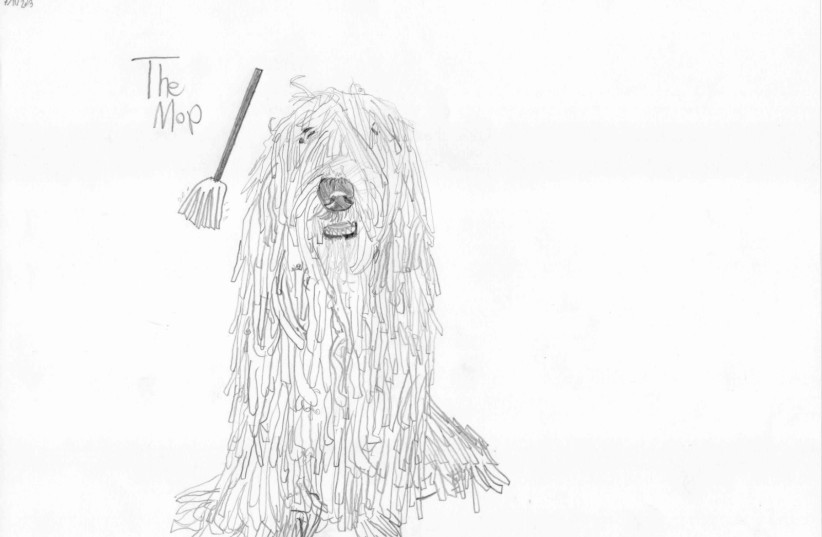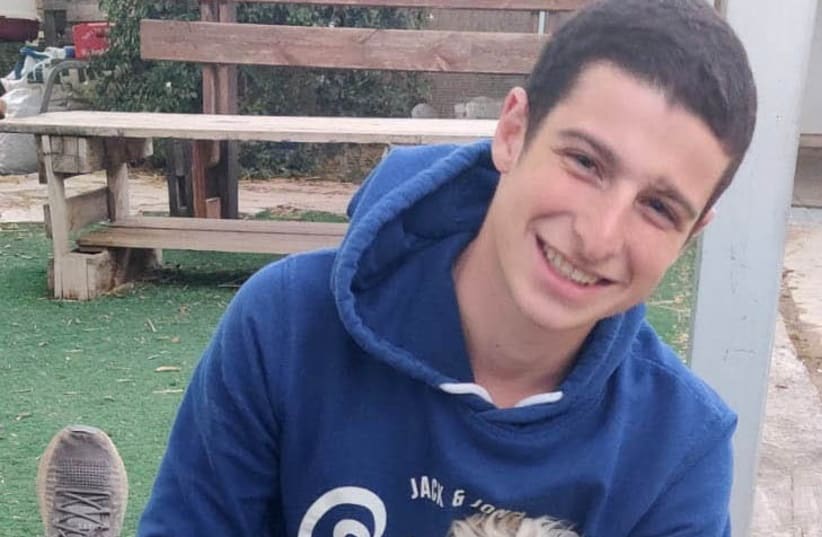Almost a year has passed since their precious son passed away, and for Lisa and Richard Isaacs the events of that night one year ago are still as shocking today as they were then – as is their immeasurable pain.
Gadi was a happy, healthy, well-balanced young man, who appeared to be coping well with the challenges of army life, making his decision to end it all unfathomable for everyone who knew him.
A source of inspiration to both his comrades and higher-ups, Gadi imbued them with the strength to keep going when the going got tough: “You turned every crap situation into a funny one without even trying,” wrote Yakir to his close friend.
“Maybe you didn’t understand it, but you put a smile on many people’s faces, including officers and commanders, in tough times, especially during advanced training,” he went on.
As a testament to his strength, courage and determination, Gadi was one of a small number of young men assigned to an elite tank unit of the Armored Corps.


Unsurprisingly, training was grueling and unrelenting, leaving him and his comrades sleep-deprived, hungry and utterly exhausted. Time spent at home was essential for these boys, even if it was only the occasional weekend.
Tragically, a catastrophic turn of events occurred when Gadi came home on that fateful weekend in May 2022, intending to get some much-needed rest and catch up with friends.
While the precise circumstances leading to his death remain unclear, we do know that Gadi – already suffering from the usual stresses and strains of army life – was under additional pressure at the time due to the “perfect storm” clouds that had gathered in his final hours.
Having eaten at home with his family on Friday night, he then met up with a friend in the park, where they shared a joint; arguably a foolish, yet harmless, thing to do.
No one, however, could have predicted the encounter that followed and the tragic chain of events that unfolded thereafter.
Gadi and his friend were spotted smoking by the police. While his friend, not yet a soldier, was quickly let go, Gadi spent an hour and a half at the police station before being released.
The full story of what happened during that time remains a mystery, although Gadi told his best friend, Aviv, in a WhatsApp message, that the police were being “aggressive and mean.”
What we do know is that this exhausted young soldier, alone and scared, resorted to taking his own life in the aftermath of that traumatic event.
IT’S IMPOSSIBLE to imagine the devastation that Gadi’s decision – made in that moment of desperation – has wreaked on his parents, older brother Nadav, grandparents, (one of whom passed away a few months later), wider family and friends.
Each has found different coping mechanisms. As Richard, Gadi’s father, said sorrowfully, “Everyone grieves differently.”
“Everyone grieves differently.”
Richard Isaacs
Throwing himself into his work helps Richard to get up in the morning and keep going. He finds it painful to talk about his son, describing it as “a wound that opens every time.”
Lisa, Gadi’s mother, a talented papercut artist and blogger, has taken a different approach. For her, work has been relegated to the back burner. Instead, she takes comfort in talking about Gadi – and her grief – with good friends who, she says, have been extremely supportive.


Gadi, like his British-born parents, was a huge football fan. Not only did he support his local team, Ironi Modi’in (for whom he designed the supporters’ scarf), but he was also an avid follower of Hull City FC, his mother’s home team, much to the chagrin of his father and brother, both Arsenal supporters.
He also adored animals, especially dogs, and could often be spotted walking dogs belonging to neighbors and friends.
LIKE HIS mother, Gadi was an artistic soul who loved to draw, read and write.
During his all-too-short life, he penned dozens of short stories in English from an early age. He also became well known for his finely detailed pen and ink drawings.
Having come to the attention of Tel Aviv art curator Shira Friedman, Gadi’s drawings are currently on show in a specially commissioned memorial exhibition in Modi’in titled The Good, The Bad and The Snoring.
The exhibition was the brainchild of Friedman, who sought permission from Gadi’s parents to arrange it in his memory as a way to showcase his talent to the wider public.
After months of planning and preparation, the exhibition is up and running. With literally hundreds of pieces to choose from (Gadi was always drawing), selecting just 45 to display was no easy task.
Although the exhibition has brought a small ray of light into the lives of Gadi’s family and friends, the gaping hole left by his loss will never be filled.
His drawings serve as a poignant reminder, to all who knew Gadi, of their tragic loss – the loss of their warm, funny, talented son, brother and friend, who was only just starting out on life’s journey.


Richard eulogized his son a month after his passing with the words, “Every waking moment is filled with you, filled with thoughts of what could have been, of what should have been.
“You were always a rough diamond, Gadi, but during this period, we have heard testimonials from so many people in your life, each one polishing the rough edges, one at a time, until a truly beautiful polished sparkling diamond has been revealed.”
He ended with the heartbreaking words, “Gadi, we miss you so, so much. Life is unbearable without you. A brilliant sparkling diamond has been revealed, only to disappear from our lives forever.
“Rest in peace, my darling Gadi.”
The Good, The Bad and The Snoring memorial exhibition of Gadi Isaacs’s drawings is on view until May 31. Sunday-Thursday from 6-9 p.m.; and Friday, May 12, from 9:30 a.m.-12:30 p.m., at Einan Hall, Azrieli Mall, Modi’in (top floor, opposite the cinema). Entrance is free.
Mental health & the IDF
Sadly, Gadi’s story is not unique.
Currently, suicide is the leading cause of death among soldiers. In 2022, 14 young soldiers are believed to have taken their own lives, a significant increase over the previous year when 11 made that decision to end it all.
While the grueling nature and pressure of the army can take their toll on these young men and women, both during and after their service, professional help is on hand through the army, private therapists and nonprofits (see below for details).
The IDF has stepped up its game enormously in this regard. It provides commanders and officers with training in order to enable them to spot the signs of mental health problems and deal with them quickly and appropriately.
A watchful eye is also kept over new recruits in basic training, those who have been transferred from other units, lone soldiers and others who are regarded as being particularly vulnerable.
Further, soldiers are also encouraged to speak to their commander or officer if they are struggling, who will refer them to a kaban (army psychologist/therapist) if necessary.
Tragically, in spite of it all, there are still those who resort to suicide. A full investigation is always carried out when this occurs in order to learn lessons and ascertain how to prevent it from happening again as far as possible.
Clinical psychologist Dr. Batya Ludman has outlined some of the ways in which soldiers can help themselves and how parents (I’m an army mom) can help them if it all gets too much and they are struggling to cope.
Talk. Soldiers should be encouraged to discuss their experiences. The first port of call should be their commander or officer if they feel comfortable talking to him or her. Sometimes this can help to resolve the issue, although there are occasions when soldiers may be referred to the kaban for more specialized help.
Where a soldier prefers not to approach the commander with a problem, Ludman stresses the importance of finding someone else to talk to, whether it be a friend in the army, parents, a partner or a private therapist outside of the army, in which case permission from the army should be sought first through the commander/officer.
The important thing is for them to find someone they trust and with whom they feel comfortable sharing their problems. This may not be the first person they seek out and speak to, and it’s essential for them not to give up and remain silent.
Parents can also help. For example, keeping a close eye (or ear) on your children when they’re home for the weekend, or when you speak to them on the phone, is important in order to ascertain whether anything is amiss.
Help them to understand what lies in store. Loss of autonomy and control goes hand in hand with army service, which can be extremely difficult, as things don’t always go according to plan. Prepare them for this, and let them know that you’re there to talk about it if it’s bothering them.
Little, easy things, too, can help you to help your children. Make sure they’re well fed; ensure they have all the basic things they might need; make time for them, even if that means chatting with them in the middle of the night, when they’ve just finished a training exercise or mission, and need five minutes to hear a friendly voice to help them relax.
Above all, it’s vitally important to let them know how much they are appreciated and valued and how proud they make us all.
Lone soldiers. Some lone soldiers, both from Israel and abroad, find the army particularly difficult, with no family support nearby or at all. Organizations such as The Lone Soldier Center in memory of Michael Levin are there to help. Lone soldiers can also call 1111 for help and advice.
Get Help Israel – The Israel Association of Mental Health Professionals – also provides reduced fees for lone soldiers.
The most important thing for those who are struggling with mental health problems, either during their service or thereafter, is not to let them spiral out of control.
Sadly, many are reluctant to seek help, even in extremis: “Even with growing awareness of the hidden epidemic plaguing Israel’s warriors, many soldiers feel they are unable to ask for help due to societal pressure, systemic challenges and personal stigmas,” Michael Starr wrote in The Jerusalem Post.
Last year, the Magazine spoke to an elite commando unit veteran who had fought in Operation Protective Edge, about his experience with trauma. He believes that a large percentage of combat soldiers suffer from combat fatigue in one form or another.
“The vast majority of people who enter these combat situations don’t leave them behind,” he said.
For any soldier – or civilian, for that matter – who is suffering from mental health problems, engaging the services of a mental health professional shouldn’t be something that is done as a last resort. Nipping the problem in the bud can arrest its development and even stop it in its tracks.
Optional contact channels for soldiers who feel mental distress/difficulty:
- Public Inquiries Office: The Public Inquiries Unit, in the Human Resources Division, is the address for IDF soldiers, commanders, and civilians. It provides answers to unique and complex issues in every field relevant to the IDF and its service in routine and emergency situations, 24/7, all year round.
Every inquiry will be answered, and you will receive a reference. You can call the office at 1111 extension 5, extension 4.
- Lone Soldier Center: The center was established two years ago to provide assistance to lone soldiers. The center responds at all times in a variety of languages. The center works in cooperation with all IDF units, as well as entities outside the IDF.
A lone soldier can contact the center on any matter at 1111 extension 2, or 052-943-7725.
- You can contact the mental health officer of each unit with any request and on any topic, using the appointment scheduling application in Mediclick.
- ARAN: This is a civil association that provides mental health first-aid service by phone and Internet 24/7. The association has a dedicated line for soldiers: *2201.
Gadi’s art: His parents’ perspective
By Lisa and Richard Isaacs
Gadi had many different hobbies in his short life, but one of the things that always stayed with him was his passion for creating and drawing. When he was in kindergarten, he would bring home models made from boxes and other types of packaging nearly every day. As he got older, he would sit at his desk creating fine pen and ink pieces, full of minute detail.
Gadi’s work was almost always in black and white. Though he had drawers full of felt tip pens and colored pencils, he preferred a simple graphite pencil and, later, a super-fine black pen and sometimes a red one. His work was small in scale but full of detail.
We knew from a young age that Gadi was talented. His early drawings are sweet and simple, but with a strong use of line to define his shapes and figures. Pictures were of animals and birds, football players and knights – typical boy themes. Later, he would draw mythical islands, maps, steampunk characters and industrial scenes.
He went through a lengthy stage of drawing football stadiums. He was fascinated not by the players but rather the crowd. He would draw each supporter in great detail, finally using a little color to show which team they favored.!
Gadi was not precious about his work. He was proud to show us his drawings when he was satisfied with them, but many pieces ended up in the trash as well.
We are able to hold this exhibition because we carefully saved what we felt were the best of them when tidying up Gadi’s incredibly messy room! Aviv, Gadi’s best friend, did the same when Gadi would leave his drawings lying around at school.
We discovered that Gadi was still drawing when he was in the IDF. His sketchbook was found in his tank, and some of the drawings have been included in this exhibition. He had told friends he wanted to make better use of the many spare hours he had, when he found himself sitting around doing very little.
We are sure that Gadi would be very proud of this exhibition and happy that so many of you are able to see his work.












